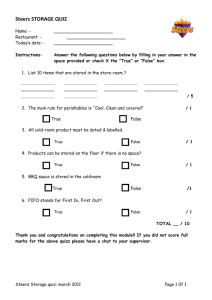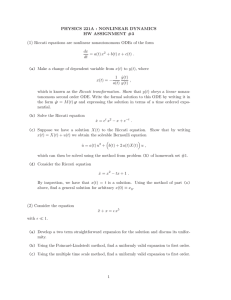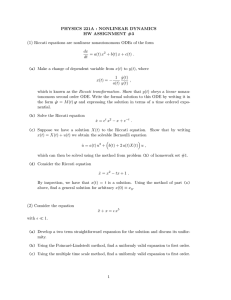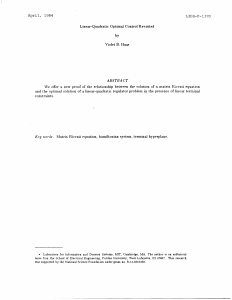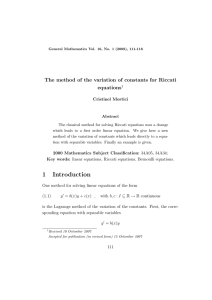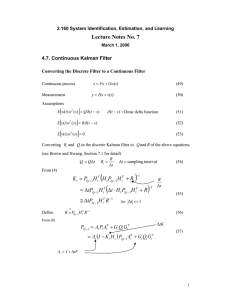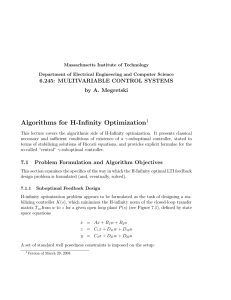Least Squares Optimization - Lecture 21 Least Squares Optimization ∗ November 29, 2012
advertisement
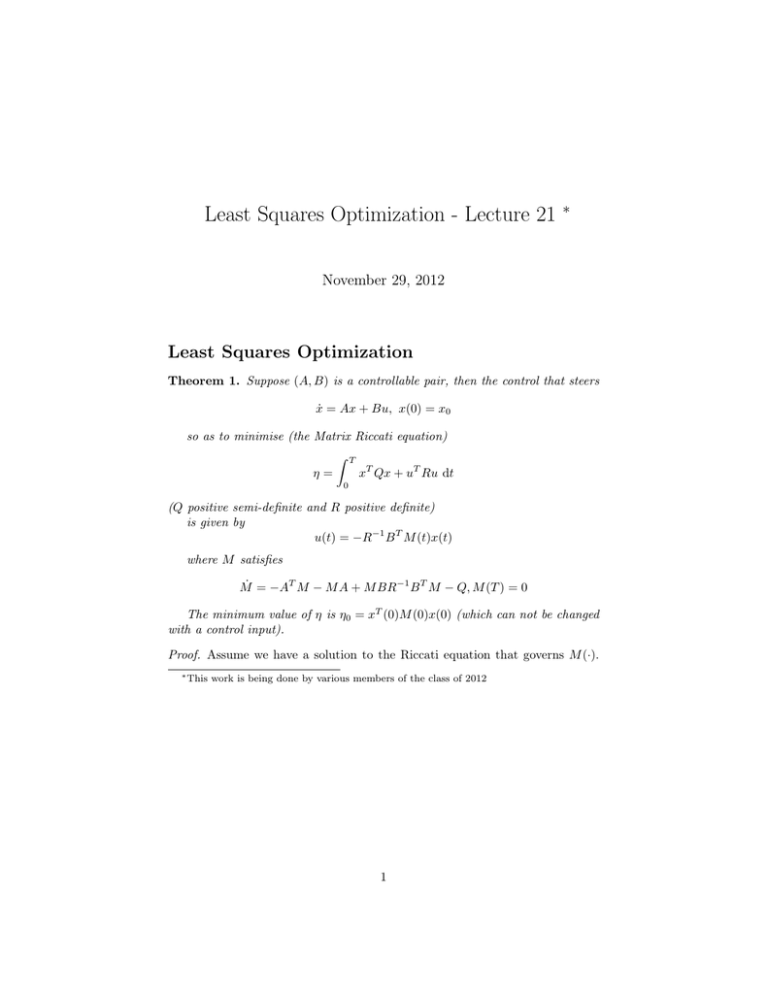
Least Squares Optimization - Lecture 21 ∗ November 29, 2012 Least Squares Optimization Theorem 1. Suppose (A, B) is a controllable pair, then the control that steers ẋ = Ax + Bu, x(0) = x0 so as to minimise (the Matrix Riccati equation) Z η= T xT Qx + uT Ru dt 0 (Q positive semi-definite and R positive definite) is given by u(t) = −R−1 B T M (t)x(t) where M satisfies Ṁ = −AT M − M A + M BR−1 B T M − Q, M (T ) = 0 The minimum value of η is η0 = xT (0)M (0)x(0) (which can not be changed with a control input). Proof. Assume we have a solution to the Riccati equation that governs M (·). ∗ This work is being done by various members of the class of 2012 1 Dynamic Systems Theory Write Z η= 2 T xT Qx + uT Ru dt 0 Z T −xT Ṁ x − xT AT M x − xT M Ax + xT M BR−1 B T M x + uT Ru dt = 0 Z = T −xT Ṁ x − ẋT Ṁ x + xT AT M x + uT B T M x − xT M ẋ + xT M Ax 0 +xT M Bu − xT AT M x − xT M Ax + xT M BR−1 B T M x + uT Ru dt Z T d = − (xT M x) + uT B T M x + xT M Bu + xT M BR−1 B T M x + uT Ru dt dt 0 Z T = xT (0)M (0)x(0) + (u + R−1 B T M x)T R(u + R−1 B T M x) dt 0 Because R is positive-definite the last (integral) term is ≥ 0. We have equality ⇔ u(t) = −R−1 B T M (t)x(t). Theorem 2. Let W be the controllability Grammanian for the system ẋ = Ax + Bu, x(0) = x0 If u0 (·) is any control of the form u0 (t) = −BΦ(t, t0 )ξ where ξ satisfies W (t0 , t1 )ξ = x0 − Φ(t0 , t1 )x1 then the control steers the system from x0 at t = t0 to x1 at t = t1 , and if u1 (·) is any other control that steers the system from x0 at t0 to x1 at t1 , then Z t1 Z t1 ku1 (t)k2 dt ≥ ku0 (t)k2 dt t0 t0 Proof. Z x1 = Φ(t1 , t0 ) x0 t1 t0 t1 Z = Φ(t1 , t0 ) x0 Φ(t0 , s)B(s)u1 (s) ds Φ(t0 , s)B(s)u0 (s) ds t0 Substracting Z t1 Φ(t0 , s)B(s)(u1 (s) − u0 (s)) ds = 0 t0 Dynamic Systems Theory 3 Premultiplication by ξ T together with the definition of u0 (·) gives Z t1 uT0 (t)(u1 (t) − u0 (t)) dt = 0 t0 t1 Z 2 2 Z t1 ku1 (t)k − ku0 (t)k dt = t0 uT1 (t)u1 (t) − uT0 (t)u0 (t) dt t0 Z t1 uT1 (t)u1 (t) − uT0 (t)u0 (t) − 2uT0 (t)u1 (t) + 2uT0 (t)u0 (t) dt = t0 Z t1 = uT1 (t)u1 (t) − 2uT1 (t)u0 (t) + uT0 (t)u0 (t) dt t0 t1 Z (u1 (t) − u0 (t))T (u1 (t) − u0 (t)) dt = t0 Z t1 = ku1 (t) − u0 (t)k2 dt ≥ 0 t0 And there is equality ⇔ u1 (t) = u0 (t). Z η= T l(x, u) d(t) + Ψ(x(T )) 0 Theorem 3 (Endpoint value penalized). Let A, B, Q, QT be matrices where both Q and QT are n × n symmetric and positive semi-definite. Let M (·) be the unique n × n positive semi-definite solution to Ṁ = −AT M − M A + M BB T M − Q, M (T ) = QT Then there exists a control u(·) that steers the system ẋ = Ax + Bu, x(0) = x0 and minimized the performance metric Z η= T xT Qx + ku(t)k2 dt + xT (T )QT x(T ) 0 The minimum value of η is xT (0)M (0)x(0), and the minimizing control is u(t) = −B T M (t)Φ(t, 0)x0 where Φ(t, t0 ) is the transition matrix associated with ẋ = (A − BB T M (t))x Dynamic Systems Theory 4 One can let T → ∞ and the form of the Riccati equation is such that we need to consider a steady-state solution K AT K + KA − KBB T K + Q = 0 If (A, B) is a controllable pair, a unique positive semi-definite solution exists. Moreover, the matrix A − BB T K has all eigenvalues in the left half-plane. With T → ∞, this linear quadratic optimization problem, becomes the quadratic regulator problem (LQR problem). 1 Fixed endpoint problems Consider ẋ = Ax + Bu, x(0) = x0 Z T η= xT (s)Qx(s) + uT (s)u(s)ds 0 Assume there is a solution to the Riccati equation Ṁ = −AT M − M A + M BB T M − Q, M (t1 ) = M1 on the interval [t0 , t1 ]. Theorem 4. A trajectory x(t) minimizes η for the given system and boundary conditions x(t0 ) = x0 , x(t1 ) = x1 ⇔ it minimizes Z t1 η̄ = kv(t)k2 dt t0 for the differential equation ẋ = (A − BB T M (t))x(t) + Bv(t) with the same boundary conditions x(t0 ) = x0 , x(t1 ) = x1 . Proof. Assume the system ẋ = Ax(t) + Bu(t) is driven from x0 at t = t0 to x1 at t = t1 by a control of the form u(t) = −B T M (t)x(t) + v(t) where M (·) is the solution of the Riccati equation given above. Dynamic Systems Theory 5 The “cost” of the control is Z t1 xT (t)Qx(t) + uT (t)u(t) dt η= t0 t1 Z −xT Ṁ x − xT AT M x − xT M Ax + xT M BB T M x = t0 T +(v − xT M B)(v − B T M x) dt Z t1 = −xT Ṁ x − xT AT M x − xT M Ax + xT M BB T M x t0 +v T v − xT M Bv − v T B T M x + xT M BB T M x dt Z t1 −xT Ṁ x − xT (A − M BB T )x − xT M (A − BB T M )x = t0 T T −V B M x − xT M Bv + v T v dt Z t1 = −xT Ṁ x − ẋT M x − xT M ẋ + v T v dt t0 T T Z = −x (t1 )M (t1 )x(t1 ) + x (t0 )M (t0 )x(t0 ) + T v T v dt 0 The first two quantities in the last relation are fixed. The only term that RT can be adjusted is the integral term 0 v T v dt. This can be minimized subject to the differential equation ẋ = (A − BB T M (t))x(t) + Bv(t) together with the boundary conditions x(t0 ) = x0 , x(t1 ) = x1 This yields an algorithm for finding the fixed endpoint control: 1. Solve the Riccati equation for M (·). 2. Use the procedure outlined at the beginning of the class to find vopt which steers ẋ = (A − BB T M (t))x(t) + Bv(t) from x(t0 ) = x0 to x(t1 ) = x1 so as to minimize the integral Z t1 kv(t)k2 dt t0 3. The control for the original problem is u(t) = −B T M (t)x(t) + vopt (t) Dynamic Systems Theory 2 6 Summary The PMP yields necessary conditions for optimal control problems of the form Find u(·) that steers the system ẋ = f (x, u) so as to minimize Z t1 l(x, u) dt + Ψ(x(t1 )) η= t0 PMP solution: there is λ(t) such that ẋ = f (x(t), u(t)), x(t0 ) = x0 T ∂l ∂f λ(t) − λ̇ = − ∂x ∂x For components of the state that are not specified at t = t1 , the corresponding components of λ(t1 ) and ∂Ψ ∂x (x(t1 )) are equal. ∂ T ∂l + (λ f (x, u)) ≡ 0 ∂u ∂u Very important special cases: 1. l(x, u) ≡ 1 corresponds to the time optimal problem (not covered). 2. l(x, u) = xT QX+uT Ru and f (x, u) = Ax+Bu corresponds to the problem of linear-quadratic optimization.
